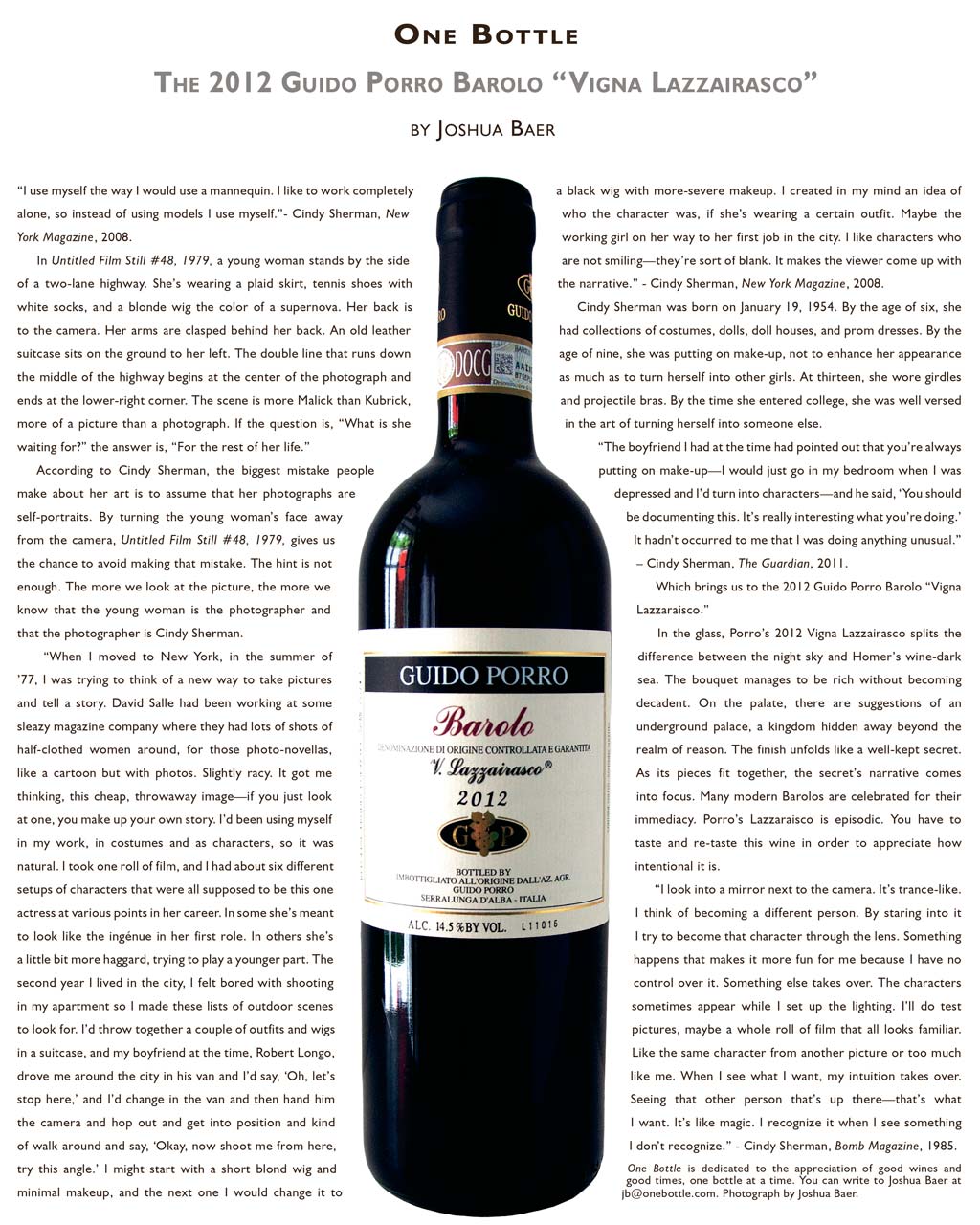2012 Guido Porro Barolo “Vigna Lazzairasco”
“I use myself the way I would use a mannequin. I like to work completely alone, so instead of using models I use myself.”- Cindy Sherman, New York Magazine, 2008.
In Untitled Film Still #48, 1979, a young woman stands by the side of a two-lane highway. She’s wearing a plaid skirt, tennis shoes with white socks, and a blonde wig the color of a supernova. Her back is to the camera. Her arms are clasped behind her back. An old leather suitcase sits on the ground to her left. The double line that runs down the middle of the highway begins at the center of the photograph and ends at the lower-right corner. The scene is more Malick than Kubrick, more of a picture than a photograph. If the question is, “What is she waiting for?” the answer is, “For the rest of her life.”
According to Cindy Sherman, the biggest mistake people make about her art is to assume that her photographs are self-portraits. By turning the young woman’s face away from the camera, Untitled Film Still #48, 1979, gives us the chance to avoid making that mistake. The hint is not enough. The more we look at the picture, the more we know that the young woman is the photographer and that the photographer is Cindy Sherman.
“When I moved to New York, in the summer of ’77, I was trying to think of a new way to take pictures and tell a story. David Salle had been working at some sleazy magazine company where they had lots of shots of half-clothed women around, for those photo-novellas, like a cartoon but with photos. Slightly racy. It got me thinking, this cheap, throwaway image—if you just look at one, you make up your own story. I’d been using myself in my work, in costumes and as characters, so it was natural. I took one roll of film, and I had about six different setups of characters that were all supposed to be this one actress at various points in her career. In some she’s meant to look like the ingénue in her first role. In others she’s a little bit more haggard, trying to play a younger part. The second year I lived in the city, I felt bored with shooting in my apartment so I made these lists of outdoor scenes to look for. I’d throw together a couple of outfits and wigs in a suitcase, and my boyfriend at the time, Robert Longo, drove me around the city in his van and I’d say, ‘Oh, let’s stop here,’ and I’d change in the van and then hand him the camera and hop out and get into position and kind of walk around and say, ‘Okay, now shoot me from here, try this angle.’ I might start with a short blond wig and minimal makeup, and the next one I would change it to a black wig with more-severe makeup. I created in my mind an idea of who the character was, if she’s wearing a certain outfit. Maybe the working girl on her way to her first job in the city. I like characters who are not smiling—they’re sort of blank. It makes the viewer come up with the narrative.” - Cindy Sherman, New York Magazine, 2008.
Cindy Sherman was born on January 19, 1954. By the age of six, she had collections of costumes, dolls, doll houses, and prom dresses. By the age of nine, she was putting on make-up, not to enhance her appearance as much as to turn herself into other girls. At thirteen, she wore girdles and projectile bras. By the time she entered college, she was well versed in the art of turning herself into someone else.
“The boyfriend I had at the time had pointed out that you’re always putting on make-up—I would just go in my bedroom when I was depressed and I’d turn into characters—and he said, ‘You should be documenting this. It’s really interesting what you’re doing.’ It hadn’t occurred to me that I was doing anything unusual.” – Cindy Sherman, The Guardian, 2011.
Which brings us to the 2012 Guido Porro Barolo “Vigna Lazzaraisco.”
In the glass, Porro’s 2012 Vigna Lazzairasco splits the difference between the night sky and Homer’s wine-dark sea. The bouquet manages to be rich without becoming decadent. On the palate, there are suggestions of an underground palace, a kingdom hidden away beyond the realm of reason. The finish unfolds like a well-kept secret. As its pieces fit together, the secret’s narrative comes into focus. Many modern Barolos are celebrated for their immediacy. Porro’s Lazzaraisco is episodic. You have to taste and re-taste this wine in order to appreciate how intentional it is.
“I look into a mirror next to the camera. It’s trance-like. I think of becoming a different person. By staring into it I try to become that character through the lens. Something happens that makes it more fun for me because I have no control over it. Something else takes over. The characters sometimes appear while I set up the lighting. I’ll do test pictures, maybe a whole roll of film that all looks familiar. Like the same character from another picture or too much like me. When I see what I want, my intuition takes over. Seeing that other person that’s up there—that’s what I want. It’s like magic. I recognize it when I see something don’t recognize.” - Cindy Sherman, Bomb Magazine, 1985.
One Bottle is dedicated to the appreciation of good wines and good times, one bottle at a time. You can write to Joshua Baer at jb@onebottle.com.
